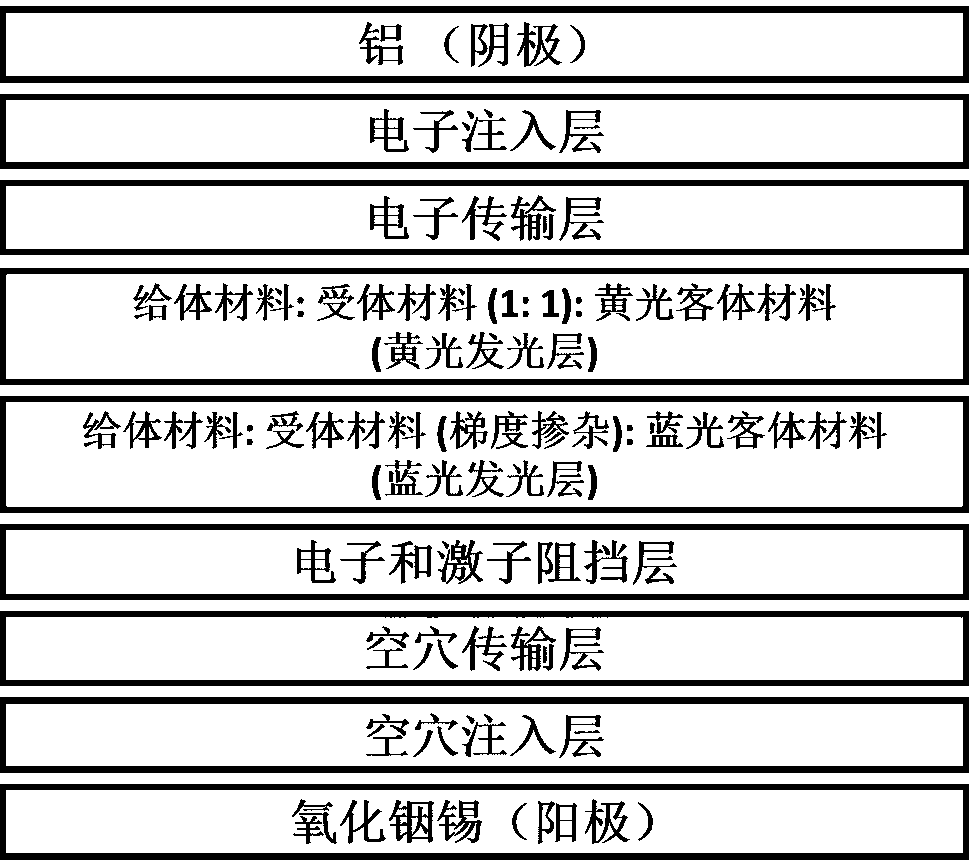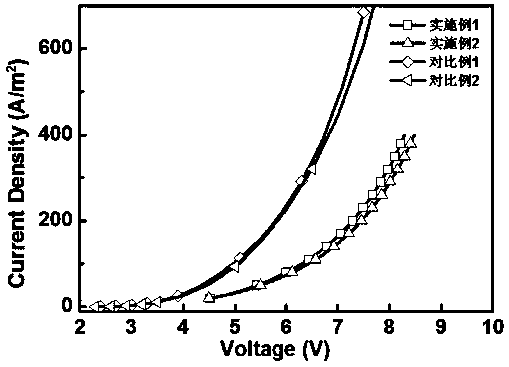Ultra-efficient organic electroluminescent diode device
A luminescence and diode technology, applied in the field of ultra-high-efficiency organic electroluminescent diode devices, can solve the problems of external quantum efficiency, power efficiency roll-off, high turn-on and operating voltage, and limited material selection, so as to reduce the external quantum efficiency of the device and Roll-off of power efficiency, reduction of turn-on and operating voltages, effects of lower selection requirements
- Summary
- Abstract
- Description
- Claims
- Application Information
AI Technical Summary
Problems solved by technology
Method used
Image
Examples
Embodiment 1
[0046] A method for preparing an ultra-high-efficiency organic electroluminescent diode device, comprising the following steps:
[0047] (1) Clean the indium tin oxide (ITO) transparent conductive glass substrate with acetone, ethanol and deionized water for three times, and then move it to a 105°C oven to completely remove the residual solvent and water on the surface;
[0048] (2) After taking out the ITO transparent conductive glass substrate, treat it with ultraviolet lamp and ozone for 15 minutes;
[0049] (3) Take it out, place it in a vacuum film deposition chamber, and vacuum it to 5.0×10 -4 Torr;
[0050] (4) Vacuum-evaporate HAT-CN on the processed ITO to form a hole injection layer, the evaporation rate is 0.4 Å / s, and the evaporation thickness is 10 nm;
[0051] (5) Continue to vacuum-evaporate TAPC on the ITO substrate on which the HAT-CN was evaporated to form a hole transport layer. The evaporation rate is 2 Å / s and the evaporation thickness is 40 nm;
[005...
Embodiment 2
[0060] A method for preparing an ultra-high-efficiency organic electroluminescent diode device, comprising the following steps:
[0061] (1) Clean the indium tin oxide (ITO) transparent conductive glass substrate with acetone, ethanol and deionized water for three times, and then move it to a 105°C oven to completely remove the residual solvent and water on the surface;
[0062] (2) After taking out the ITO transparent conductive glass substrate, treat it with ultraviolet lamp and ozone for 15 minutes;
[0063] (3) Take it out, put it in the vacuum film deposition chamber, and vacuum it to 6.0×10 -6 Torr;
[0064] (4) Vacuum-evaporate HAT-CN on the processed ITO to form a hole injection layer, the evaporation rate is 0.4 Å / s, and the evaporation thickness is 10 nm;
[0065] (5) Continue to vacuum-evaporate TAPC on the ITO substrate on which the HAT-CN was evaporated to form a hole transport layer. The evaporation rate is 2 Å / s and the evaporation thickness is 40 nm;
[006...
Embodiment 3
[0074] A method for preparing an ultra-high-efficiency organic electroluminescent diode device, comprising the following steps:
[0075] (1) Clean the indium tin oxide (ITO) transparent conductive glass substrate with acetone, ethanol and deionized water for three times, and then move it to a 105°C oven to completely remove the residual solvent and water on the surface;
[0076] (2) After taking out the ITO transparent conductive glass substrate, treat it with ultraviolet lamp and ozone for 15 minutes;
[0077] (3) Take it out, place it in a vacuum film deposition chamber, and vacuum it to 5.0×10 -6 Torr;
[0078] (4) Vacuum-evaporate HAT-CN on the processed ITO to form a hole injection layer, the evaporation rate is 0.4 Å / s, and the evaporation thickness is 10 nm;
[0079](5) Continue to vacuum-evaporate TAPC on the ITO substrate on which the HAT-CN was evaporated to form a hole transport layer. The evaporation rate is 2 Å / s and the evaporation thickness is 40 nm;
[0080...
PUM
| Property | Measurement | Unit |
|---|---|---|
| Thickness | aaaaa | aaaaa |
Abstract
Description
Claims
Application Information
 Login to View More
Login to View More - R&D
- Intellectual Property
- Life Sciences
- Materials
- Tech Scout
- Unparalleled Data Quality
- Higher Quality Content
- 60% Fewer Hallucinations
Browse by: Latest US Patents, China's latest patents, Technical Efficacy Thesaurus, Application Domain, Technology Topic, Popular Technical Reports.
© 2025 PatSnap. All rights reserved.Legal|Privacy policy|Modern Slavery Act Transparency Statement|Sitemap|About US| Contact US: help@patsnap.com



